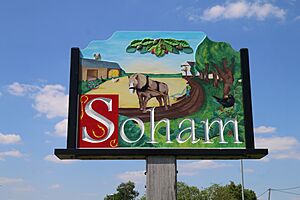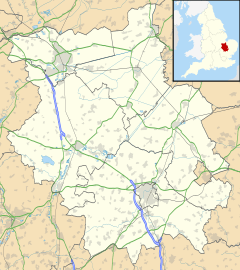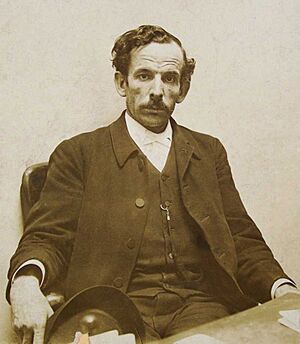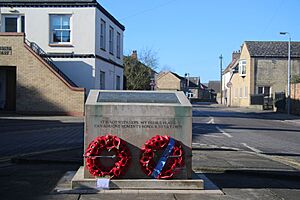Soham facts for kids
Quick facts for kids Soham |
|
|---|---|
 Soham town sign |
|
| Area | 8.2 sq mi (21 km2) |
| Population | 12,336 |
| • Density | 1,504/sq mi (581/km2) |
| OS grid reference | L591732 |
| Civil parish |
|
| District |
|
| Shire county | |
| Region | |
| Country | England |
| Sovereign state | United Kingdom |
| Post town | ELY |
| Postcode district | CB7 |
| Dialling code | 01353 |
| Police | Cambridgeshire |
| Fire | Cambridgeshire |
| Ambulance | East of England |
| EU Parliament | East of England |
| UK Parliament |
|
Soham (pronounced SOH-əm) is a town and civil parish in Cambridgeshire, England. It is located near the A142 road between Ely and Newmarket. In 2021, about 12,336 people lived there.
Contents
Discovering Soham's Past
Ancient Finds and Early Settlements
The area around Soham has many exciting archaeological discoveries. These finds show that people lived here during the Stone Age, Bronze Age, and Iron Age. For example, people have found collections of bronze objects, including swords and spearheads. A gold torc (a type of necklace) was also found in 1938.
In 2013, a large Anglo-Saxon village was discovered. It was next to Roman remains. When a cemetery was built in the late 1800s, ancient burials were found. These burials included special items like jewelry, which are now kept in the British Museum. More Bronze and Iron Age settlements have also been found in the north of the town.
The Meaning of Soham's Name
The name 'Soham' has been spelled in different ways over time, like 'Soeham' and 'Seaham'. The Anglo-Saxon name was 'Soegham'. This name likely comes from old words meaning "wet" or "swampy." This makes sense because Soham was once surrounded by water.
Long ago, there was a very large lake called Soham Mere near the town. It was one of the biggest lakes in England. Places like Eye Hill and Eau Fen also remind us that the land used to be very watery. Some people even thought Soham was a seaport town, trading with places like King's Lynn. However, by 1813, the lake had been drained and turned into farmland.
King Cnut and Soham Mere
There's an old story about King Cnut visiting the monks in Ely. He needed to cross the frozen Soham Mere. His nobles were worried the ice would break. But King Cnut insisted on going. A local fenner (someone who lives in the fens) named Brethner offered to lead the way. King Cnut said if the ice could hold Brethner, it could hold him. So, they followed Brethner across the "bending and cracking ice." Because of his bravery, King Cnut set Brethner free and gave him some land.
St Felix and Soham Abbey
Around 630 AD, Felix of Burgundy, who was known as the 'Apostle of the East Angles', started Soham Abbey in Soham. Sadly, the Danes destroyed it in 870 AD. Later, around 900 AD, an Anglo-Saxon nobleman named Luttingus built a cathedral and a palace in Soham. These were built where the current Church of St Andrew stands today.
St Andrew's Church was built in the 12th century. Some parts of the older Saxon cathedral are thought to still be inside the church. The church's tall tower was added in the 15th century. It has ten bells, some of which are very old!
Olaudah Equiano: An Anti-Slavery Hero
Olaudah Equiano, also known as Gustavus Vassa, was a very important person. He was one of the first black British authors and a strong activist against slavery. He married Susannah Cullen from Soham on April 7, 1792, at St Andrew's Church. They lived in the town for several years.
They had two daughters, Anna Maria and Joanna. Both were born in Soham and baptized at the parish church.
William Case Morris: Helping Children
William Case Morris (1864–1932) was born in Soham. When he was young, he moved to Argentina. He was very sad to see so many poor street children there. This led him to start several homes for children in Buenos Aires.
William Morris returned to Soham before he passed away in 1932 and was buried in the Fordham Road cemetery. He is remembered with a statue in Buenos Aires. Many places, like railway stations and a town, are named after him. His work continues today through children's homes that help kids in need.
Soham Rail Disaster: A Story of Bravery
On June 2, 1944, during World War II, Soham faced a huge danger. A train carrying a lot of ammunition caught fire as it slowly passed through the town. Four brave railway workers saved Soham from being destroyed.
Driver Benjamin Gimbert, fireman James Nightall, signalman Frank Bridges, and guard Herbert Clarke quickly uncoupled the burning wagon from the rest of the train. They drove the engine and the burning wagon away from the town. The wagon then exploded, preventing a much larger disaster that would have harmed many people. Jim Nightall and Frank Bridges sadly died in the explosion, but their actions saved countless lives. Ben Gimbert survived, though he was injured.
Both Benjamin Gimbert and James Nightall were awarded the George Cross for their incredible bravery. A special memorial was put up in Soham on June 2, 2007, to remember their heroic actions.
Schools in Soham
Soham has several schools for children of different ages:
- Soham Village College
- St Andrew's Primary School
- The Weatheralls Primary School
- The Shade Primary School
- Little Wombatz (Pre-School)
Getting Around Soham
The A142 road goes past Soham, connecting Ely and Newmarket. Soham also has a bus service that runs between Newmarket and Ely.
The Soham railway station was closed to passengers in 1965. However, after many local people campaigned for it, a new station was built on the old site! It reopened in December 2021. The first passenger train in 56 years stopped at Soham Station on December 13, 2021.
Soham in the News
Local news and TV shows for Soham are provided by BBC East and ITV Anglia. You can also listen to local radio stations like BBC Radio Cambridgeshire and Heart East. The town's local newspapers are the Ely Standard and Cambridge News.
Sports and Fun in Soham
The Ross Peers Sports Centre is a great place for activities. It has a club for indoor bowls and a rink hockey team.
Soham also has two non-league football clubs: Soham Town Rangers F.C. and Soham United FC.
See also
 In Spanish: Soham para niños
In Spanish: Soham para niños




